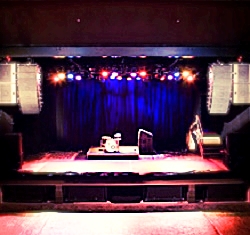
To illustrate, look at the simulations shown below (Figure 6), which show such a condition performed with the EASE sound system design software package.
Two loudspeakers with low directivity control have been separated by two feet.
The resultant does not represent accurate sound reproduction and can cause the afore-mentioned problems with acoustic gain and speech intelligibility.
Please note that it is certainly possible to build quality “arrayable” loudspeakers, and there are a number of good examples in the marketplace.
However, all of them have several parameters in common:
1. Large physical size
2. Horn-loaded components
3. Aggressive pattern control to minimize interaction with adjacent loudspeakers
If these loudspeaker requirements present problems for a particular venue due to the required large physical size, then smaller loudspeakers can be used (usually in greater number) if they are placed sufficiently close to the listeners (i.e. exploded arrays or distributed systems).

Radio broadcast engineers have understood for years the importance of proper antenna array design to control lobing in RF radiation to steer their signal to certain areas within the listening range and away from others.
For instance, if a station is licensed to radiate 50 killowatts of power, they can use an antenna array to steer the radiated signal up and down an interstate highway rather than out across a sparsely inhabited area. In fact, if they do it wrong, they can be in violation of federal law and therefore subject to prosecution.
Loudspeaker array designers must work with the same physical laws and principles as antenna designers. The only difference is that they can’t be prosecuted for bad sound.
Balloon plots are useful because they show the three-dimensional radiation pattern from a loudspeaker or group of loudspeakers located at the center of the balloon.
The plot describes what is happening at a single frequency. The plots can be generated for multiple frequencies to more fully describe the performance of an array. The balloon plot of a “perfect” loudspeaker would be the same, regardless of frequency.
Comb filtering in the magnitude response (a measurement at a single point in space) is evidence of lobing in the spatial radiation of the array.
